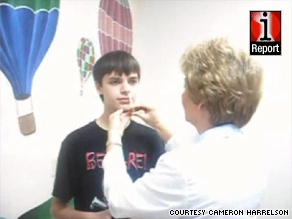Yessica Maher of Los Angeles, California, feels let down. She had wanted to get the H1N1 vaccine for herself and her children, but that's proving to be difficult.

Her doctor is out of the vaccine, and so is the pediatrician. Her two older sons were not eligible for the nasal spray version because of asthma, and she was told the shot would not become available until perhaps November. Her youngest son, 2, goes to a preschool where there was recently a diagnosis of H1N1.
"I feel that the government and health officials, they knew this was big when it first started, they know the size of our population before it started, and they didn't make leaps and bounds to make sure it was available to everyone when they would need it," she said. "It shouldn't be a supply-and-demand thing."
The Centers for Disease Control and Prevention announced last week that production of the vaccine is slower than expected. While the CDC had hoped for 40 million doses by the end of October, the real numbers will be about 30 million doses because of manufacturing delays, said Dr. Anne Schuchat, CDC's director of the National Center for Immunization and Respiratory Diseases.
Public health departments across the country are quickly running out of H1N1 vaccine and don't know when the next batches will arrive.
"We wait by the door every day to see if vaccine is going to come," said Erin Sutton, spokesperson for the Virginia Beach Health Department in Virginia. "With the overall delay from the manufacturing company, [it] has caused a great deal of frustration and problems."
A CNN/Opinion Research Corporation poll based on interviews with 1,038 adult Americans found that 49 percent of people said the swine flu vaccine is safe, while 43 percent said no. The poll of 1,038 adults was conducted by telephone October 16-18 and had a margin of error of plus or minus 3 percentage points. iReport.com: Getting the vaccine
But not everyone who wants the H1N1 vaccine can get one.
The East Metro Health Department near Atlanta, Georgia, gave out all of its approximately 6,000 doses of the FluMist version between Saturday and Tuesday, and has "no idea" when more will arrive, said Suleima Salgado, public information officer for the district.
People generally aren't complaining about the lack of vaccine, however, she said.
"We were pretty proactive about educating them and letting them know that it was slowly coming in bits and pieces," she said. "We just encouraged them to be patient, and as it continues to come, we'll continue to distribute it."
Public health departments have been flooded with calls from people wanting to know where they can get the vaccine. Michelle Peregoy, spokesperson for the Virginia Department of Health, said the department gets about 700 calls a day.
In Ventura County, California, the H1N1 hotline was ringing every 2 minutes Wednesday, said Mary Leu Pappas, who teaches nursing and volunteers with the hotline.
She typically gets asked where the vaccine is available and why certain people can't get it. Some older people want to know why they are not in the priority group, and Pappas explains that this age group may be less likely to become critically ill because of prior exposure to influenza outbreaks of decades past.
In some cases demand has outstripped supply, although more vaccine is on the way, Peregoy said.
"We're definitely seeing a lot of the school clinics that have been scheduled postponed until the local health departments get additional shipments," Peregoy said.
In Virginia Beach, there isn't enough staff to administer vaccines in all schools, so only public schools are getting them, Sutton said. However, the public health department is making separate opportunities for children in private schools and day care centers to get vaccinated. But at the moment, there is no vaccine available in the community.
Polk County, Iowa, ran out of the vaccine last week, but is holding another vaccination clinic on Sunday.
"Until the size of our shipments increase we need to focus on the people who are at the greatest risk of becoming hospitalized [if infected]," said Terri Henkels, Polk County Health Department Director, in a statement.
Priority groups for the vaccine include pregnant women, caregivers and household contacts of children younger than 6 months, people between the ages of 6 months and 24 years, and anyone ages 25 to 64 with existing health problems. Health care and emergency medical services personnel in contact with high-risk patients, or patients with flu-like illness, are also on the list.
"We know there will not be enough of the H1N1 shots for everyone who wants one," she said.
Montgomery County, Maryland, is also focusing on the priority groups, although no one can actually be turned away for not being in those groups, said Mary Anderson, public information officer for the health department. iReport: People wait in line for vaccine in Silver Spring, Maryland
The people who did walk away from clinics Wednesday without a vaccine were those looking for an injectable version, of which only 249 had been available. They showed "a mixture of resignation, sprinkled with frustration -- concern just wondering when we'd be getting more injectable. And we don't know," she said.
The county has a little more than 3,000 doses of the nasal spray vaccine left, and no injectable vaccines.
For those who have gotten the vaccine, it's a relief.
"I feel much better, safer, glad I took another step," said Cameron Harrelson, 16, of Baxley, Georgia, who contributed a video about his experience to iReport.com.











